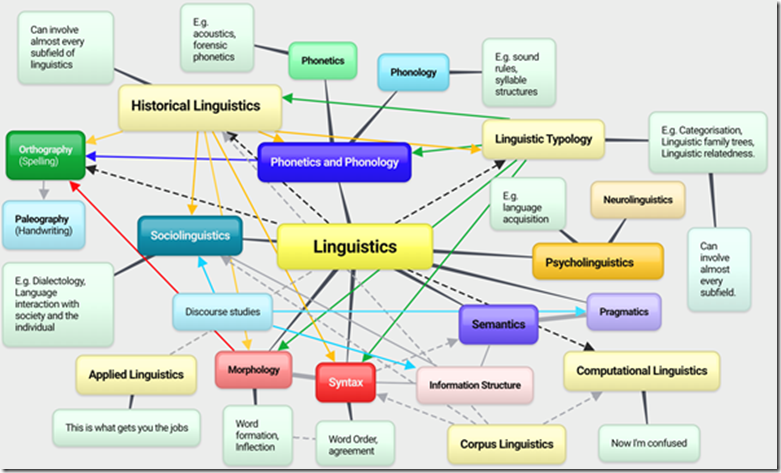Originally posted on May 26, 2022 @ 2:40 PM
Culture Silences in Safety – Linguistics
As we continue this theme of culture silences in safety we also must consider the nature of linguistics, language and discourse. Language is the bedrock of culture. When we fly to another country or move about in our own country to other cultures, the first indicator of difference is not just appearance but difference in language.
Artefacts, symbols, meaning, purpose, belief, the unconscious, embodiment and mythology are all communicated through linguistics and para-linguistics. If you want to understand culture, start with Linguistics. This little overview might help give an idea of what Linguistics is about, (see Figure 1. Linguistics)
Figure 1. Linguistics
Of course, there is much more to Linguistics that what is represented here but it is a good start when considering how to understand culture. This is why we study Linguistics in the Social Psychology of Risk (SPoR) (https://cllr.com.au/product/linguistics-flyer-unit-21/ ). We also offer studies in culture (https://cllr.com.au/product/culture-leadership-program-unit-15-overseas-elearning/ ).
Language is developed by the amalgamation of gesture, symbolic knowing and voice. A young child learns to communicate through gesture very quickly and learns through mimesis, hundreds of gestures well before speech develops. It will then be at least a few more years before that will learn text.
Gesture is the foundation of language development (https://www.frontiersin.org/articles/10.3389/fpsyg.2014.00506/full ) and so once gesture is anchored it is then connected with meaning to sounds/voice. Understanding the development of language semiotically is critical in realising both the semantics of speech but also the importance of gesture in understanding culture.
Language is acquired through embodiment (https://www.researchgate.net/publication/311436117_The_embodied_development_of_language ). This is why embodiment is foundational to an understanding of culture and why all forms of para-linguistics are essential in unconscious communication, understanding ritual and messaging. The best place to start understanding the cultural significance of gesture and unconscious communication is with McNeil
- https://mcneilllab.uchicago.edu/pdfs/gesture.thought.fundamentals.pdf
- https://mcneilllab.uchicago.edu/pdfs/gesture.a_psycholinguistic_approach.cambridge.encyclop.pdf
Understanding body Language is a sub-set of para-linguistics. Para-linguistics include: haptics, gestures, proxemics, face and body semiotics, appearances, affordances, eye language and embodied artefacts. Much of what is communicated in para-linguistics is given and received unconsciously so, behaviourist assumptions are irrelevant because what is being communicated cannot be observed or measured. So much for Safety’s fixation on measurement.
Much of what we learn in language is enculturated, not taught behaviourally. This is why behaviourism and scientism are such a burden on the safety industry and why many strategies Safety adores simply don’t work.
One of the main detractions from cultural change in safety is the simple fact that Safety speaks nonsense to people (https://safetyrisk.net/talking-zero-nonsense-to-people/ ). When you ‘frame’ your language about risk through absolutes, perfection and ‘believe the impossible’, no wonder you get cultic nonsense from safety. When all that is said is in denial of fallibility and the reality of being, no wonder the only place to turn is to a cult. Don’t let intelligence get in the way, just believe zero (https://safetyrisk.net/believe-the-impossible-and-speak-nonsense-to-people/ ).
The cult of zero is the enemy of learning. The ideology of zero is toxic to culture. The cult of zero asks that you consider it as a ‘spirit’ that restores limbs, vanishes injury and brings apocalyptic hope (https://safetyrisk.net/the-spirit-of-zero/), it does none of these.
So, if you want to get a snapshot of culture in your organisation, you don’t need any of these so-called ‘culture surveys’ on the safety market. None of them have much to do with culture. Just do a simple assessment of the linguistics and para-linguistics in your organisation and that will tell you a great deal about your culture without any need to empty your bank account or buy the latest snake oil.




Brent Charlton says
This has been a great series, Rob. I’m going to compile the articles and have all my group read them.
Rob Long says
Hi Brent, thanks, still a few more to go in the series and yes, lots to learn. Certainly ‘what we do around here’ is a complete waste of space and so unhelpful.